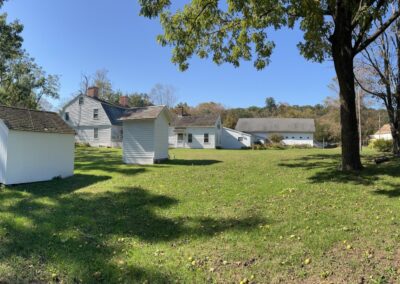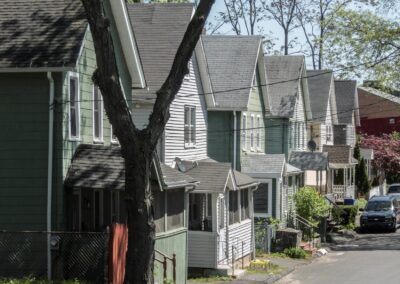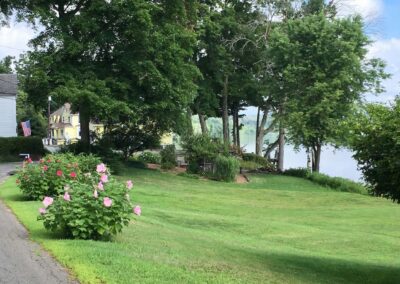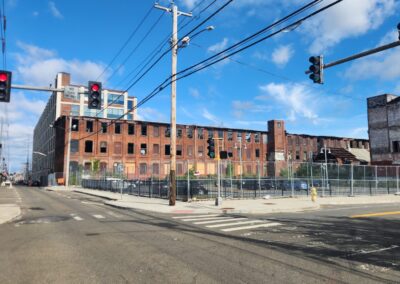News from the State Historic Preservation Office
by Jenny Scofield, Deputy State Historic Preservation Officer and National Register Coordinator, State Historic Preservation Office
Editor’s note: This article originally appeared in the September/October 2025 issue of Preservation Connecticut News; however, some text was inadvertently omitted.
Preservationists have long recognized historic districts as complete, significant places with multiple features that share historic associations and, typically, geographic proximity. Historic downtowns, neighborhoods, village centers, recreational facilities, farms, corporate or institutional campuses, industrial complexes, parkways or transportation corridors, landscapes, canals, and archaeological sites throughout the state are recognized as districts. While districts may contain a mix of resource types, each historic component contributes to the overall historic significance and understanding of that place. Consider, for example, an historic farm; what would the farmhouse be without the related outbuildings and landscape features, such as fields, orchards, shade trees, ponds, and stone walls? The house may survive as an expression of vernacular architecture, but an understanding of the property’s agricultural importance is diminished by the loss of the farm’s other features.
While districts often contain some historic resources that would not be eligible for historic designations on their own, they should not be considered simply as a collection of individually unimportant things. Defining a district is a way to describe a historic resource that has multiple significant features The Whistleville National Register historic district in Norwalk, which was designated for its associations with ethnic heritage, consists primarily of vernacular worker housing, along with commercial buildings and churches that supported the community. This neighborhood developed beginning in 1874 because of the Hungarian and Italian immigrants who traveled directly to South Norwalk for employment in the area’s many mills and the late-19th through early 20th-century industrial boom along the new railroad line. Any one of the 276 contributing properties, taken alone, would not fully express Whistleville’s vibrant immigrant history. The uninterrupted streetscapes convey a sense of the lifestyle and economy, experienced by its historic occupants, and European influence is seen in small construction details throughout the district.
Each component of a district contributes to the feeling and experience of that distinct place. The sizes, textures, materials, and arrangement of features are integral to the overall physical form. Historic downtowns, for example, have a readable development pattern that is visible in the age of buildings, placement of civic structures and public spaces, and street layout. Building setbacks, materials, and ornamental features contribute to the rhythm of each streetscape, along with the landscaping. This is not to say that districts are uniform, but rather, each resource plays a role in how that area is shaped. New Britain’s late-19th-century establishment as a culturally diverse commercial and civic center can be seen in the elaborate masonry buildings along Arch and Main Streets, the central square, and soaring churches. Such downtowns can suffer from cumulative losses that start to break apart the aspects of an area that make it identifiable. Even losses of resources less remarkable in design or association can muddle the area’s historic associations and create spaces in the landscape that are awkwardly empty or susceptible to over-scaled redevelopment.
At a mill complex, the scale of production can be seen in the monumentality and density of the buildings. Manufacturing processes for specific goods are evident in specialized building types and construction. Power generation can be understood through the natural terrain and waterpower features like dams, canals, or operating mechanisms. Transportation connections might include rail spurs, or proximity to water, or overland shipping routes. All these features connect to display the area’s industrial past and serve as tangible reminders of labor history. In places with substantive losses like the Railroad Avenue industrial historic district in Bridgeport, just a couple blocks of loft buildings remain to mark the location of a formerly immense cluster of manufacturing concerns. While larger districts may be able to sustain more change than smaller-scale places without losing their historic character, every loss chips away at the area’s historic significance.
The importance of contributing features in a district is not just architectural. In the Higganum Landing historic district overlooking the Connecticut River, the positioning of the houses and a landscape swale leading to the riverbank both relate to the district’s shipbuilding history. Many of the captains’ houses in the High Street historic district in Clinton back up to a navigable waterway and incorporate foundations made of granite, shipped locally. The district of modest buildings represents a more regional maritime trade economy, as opposed to the ornate buildings in Connecticut’s larger historic ports.
The hierarchy of features within a district also plays a part in creating a complete picture of a historic place. Vernacular, or secondary features of a district should not be dismissed just because they are simpler in design or utilitarian in function. Outbuildings and domestic quarters on former estates offer insight into the labor and social history of such places. The variety of housing types in a neighborhood may be associated with layers of history over time or represent different economies and social structures. With resources like the Merritt Parkway, the lack of visual clutter in the landscape, road dimensions, plantings, and topography are just as vital to the experience of the drive as the scenic bridges and planned vistas.
More than 55,000 properties in Connecticut contribute to local, state, and national historic districts. These represent all aspects of Connecticut life. Stories of economy, industry, immigration, design, culture, inspiration, and creativity; struggles and lessons learned, are experienced in these places that contribute to Connecticut’s personality. To erode them is to lose that tangible history. That does not mean that places must freeze in time or cannot be updated, but they should be cared for, respected, and appreciated.
Darling family farmstead, Woodbridge: the house and outbuildings are all crucial to understanding the farmstead’s agricultural importance. National Register of Historic Places, James Sexton
Streetscape, Whistleville historic district, Norwalk: in spite of later siding and the loss of some details, the forms, scale, rhythm, and setbacks of these simple vernacular houses still reflect the district’s historic history. National Register of Historic Places, Tod Bryant
Higganum Landing district, Haddam: this landscape swale, providing access to the river, relates to the district’s shipbuilding history. National Register of Historic Places, Jay Verney




